Apple snails

More in dept information is available in the other sections of this website (all in english) and on the website of (your name) at (your URL).
|
Apple snails |

|
|
| The basic guide for keeping apple snails
in an aquarium or a pond (English version). More in dept information is available in the other sections of this website (all in english) and on the website of (your name) at (your URL). |
||
|
|
||
Introduction
The apple snail family or Ampullariidae are common freshwater snails in many
tropical area's around the world and several species have made their way to
the aquarium trade to become a popular pet snail.
Their attractive appearance and relatively big size (5 to 15 cm / 2 to 6 inch,
depending of the species) greatly contribute to their success. However, despite
it's popularity, many misconceptions still surround these also called mystery
snails. For instance, most popular aquarium books refer to these snails with
Ampullaria gigas and Ampullaria cuprina, while these names are
both erroneous and obsolete in the scientific literature for years. Historically
seen, these name problems are well understandable as many of works from the
authors who described these snails back in 18th and 19th century are unknown
in the hobbyist literature.
Under the currently accepted nomenclature the apple snail family (Ampullariidae)
is divided in several genera: Asolene, Felipponea, Marisa and
Pomacea are the New World genera (South America, Central America, the
West Indies and the Southern U.S.A.), while the genera Afropomus, Lanistes
and Saulea are found in Africa. The genus Pila is native in
both Africa and Asia.
The separated sexes in apple snails is another common misconception. Contrary
to what most people thinks, not all snails are hermaphroditic with apple snails
being an example amongst many others. This knowledge is quite important when
people would like to breed these snails or just want to prevent them doing
so. Unfortunately it's difficult to determine the sex of in most apple snail
species solely on their appearance, unless they mate or when the female deposits
her eggs.
Habitat and adaptation
Apple snails inhabit a wide range of ecosystems from swamps, ditches and ponds
to lakes and rivers. The majority of the species prefer lentic water above
streaming water and only a few species have adapted to rivers with strong
current.
|
|
The lung/gills combination in apple snails reflects their adaptation
to habitats with oxygen poor water. This is often the case in swamps and shallow
waters. The without thelung they would completely depend on their gills, which
would decrease their ability to survive.
Another advantage of air breathing in combination with a shell door (operculum)
is the ability to survive periods of drought often common in these habitats
during the dry season. In such cases they bury themselves into the substrate
and to aestivate with their shell firmly closed. When circumstances allow the
snails to be active during the whole years (no drought and no cold), they do
not aestivate and are active during the whole year. Besides the protection against
drought, the shell door also protects the snails against predators.
Many species, particularly of the South-American genus Pomacea, have
another remarkable anatomical feature: a breathing siphon. This organ, formed
by a fold of the mantle cavity at the left side of the head, is a barely visible
when not in use. At times the snail needs to refresh the air inside the lung,
the muscles in this fold contract and the fold changes into a flexible tube-like
structure (siphon), which enables the snail to breathe air while staying submerged.
Staying submerged provides the apple snail with a great advantage because they
are very vulnerable to snail eating birds at the surface.
Another, even more striking characteristics of apple snails are their aerial
eggs. When the time has come, the female snail leaves the water to deposit
her eggs on a stem of emergent aquatic vegetation, a trunk, a rock or any
other hard object. This unique behaviour is as far as known only existing
in the apple snail family. Nevertheless, not all apple snails lay their eggs
above the water, the snails from the genera Asolene, Felipponea,
Lanistes, Marisa and possibly also Afropomus and Saulea
lay their eggs in gelatinous eggs masses in the water on aquatic vegetation,
stones or any other object.
Common aquarium species
Identification of apple snails can be important as the feeding habits of the
species differ slightly. To simplify the whole matter one can state that if
the animal is bought in a shop, you probably have a Pomacea diffusa (mystery
snails, spike-topped apple snail, ivory snail,) or a Pomacea canaliculata
apple snail and if the snail has a flat shell and has a size over 2.5 cm (1
inch) with or without dark stripes, you are the owner of a Marisa cornuarietis
apple snail (Giant ramshorn snail). This snail is not always recognised as an
apple snail due to its different appearance. Less common, but also occasionally
available in the aquarium trade (mainly in the U.S.A.) is Pomacea paludosa
(Florida apple snail).
Only the popular Pomacea diffusa snail is suited for planted tanks
as this snails mainly feeds on dead and rotting materials and because of their
soft teeth they are unable to devour your nice aquatic vegetation.
|
|
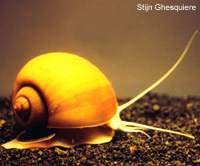 Yellow Pomacea canaliculata. The natural variety has a brown shell with dark bands. |
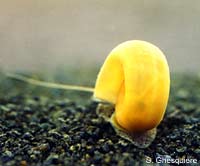 Marisa cornuarietis or Giant Ramshorn snail. |
Below is a quick and dirty guide to identify them based on
the shape of the shell.
Important: Ignore the colour of your snails when you try to determine the
species by comparing them with pictures. Many colour variations (shell and
body) exist within a single species (see photograph of Pomacea diffusa
snails above).
Sometimes other apple snail species pop-up in the trade, mostly imported species.
In these cases, it can be quite difficult to identify them.
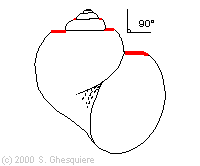 Pomacea diffusa: flat shoulders and 90° sutures. The flat shoulder, however, becomes less apparent in the last whorls of the shell. Size: 45 to 65 mm. |
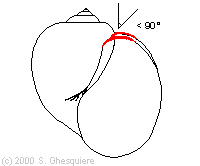 Pomacea canaliculata and Pomacea insularum: indented sutures, less than 90°angle. This shell is more globose (rounder) than the Pomacea diffusa shell. Size: 45 to 80 mm. |
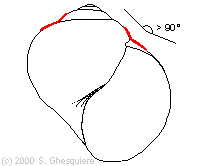 Pomacea paludosa: Almost flat sutures with an over 90° angle, which gives the snail a cone shaped shell top (spine). Size: 45 to 65 mm. |
Care and breeding
Housing
Apple snail can easily kept in a standard fish tank, but the great appetite
for aquatic plants of most apple snails do not make them a good choice for everyone.
However, as stated before, Pomacea diffusa is an exception and even
starves to dead between fresh aquatic vegetation of not provided with adequate
amount of food. Unfortunately, most people, even those in the pet shop, are
unaware of these differences and consider all these snails to be harmful to
the vegetation (yet another misconception).
Apple snails can live together with most fish without problem, but snail eating
fish species should be avoided (obvious). Also many fish will try to nip at
the tentacles of the apple snails, but that should not be a problem, as the
apple snails will adapt quickly by keeping their tentacles under their shell.
In general at least 10-liter water for each medium sized apple snail is advised.
Furthermore a coverplate to close the tank of is necessary in order to avoid
nightly escapes. You won't be the first to find your snail on the ground!An
airspace of several centimeters between the water and coverplate, to provide
these snails with fresh air, is a necessary. Even they do have gills besides
their lung; they will drown if left without air. In case one would like to breed
these snails, an airspace of about 10-cm is a needed because the snails will
otherwise have difficulties to deposit their eggs above the water.
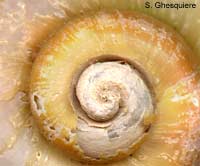 When the calcium concentration of the water is too low, the shell detoriates and holes appear (Pomacea diffusa). |
Water quality
Apple snails are not demanding on water quality: they will survive harsh
conditions better than most fish. In general, the same rules apply as one would
use fro fish to keep the water quality witin acceptable limits (filtration,
regular water changes etc.). However, as snails need calcium to construct their
shell, they prefer hard (calcium rich) water. To protect the shell, the pH of
the water should be kept at 7 (neutral water) or higher (alkaline). It's important
to pay attention to this. If the water is too soft, one can increase the calcium
concentration by adding powdered marble, lime stone, sea shells or one of these
preparates sold in pet shops for this purpose.
Food
Apple snails are very easy when it comes to food and they eat almost anything
they can tear pieces off and put in their mouth. Vegetables like cucumber, spinach,
carrots and lettuce, fish food, dead fishes, other snails and their eggs, algae,
brine shrimps, they eat it all. As mentioned before, Pomacea diffusa does
only eat very soft and dead vegetation and can better be feeded with fish food
pellets or with cooked vegetables or canned spinach. Be carefull not to foul
the water with these types of food.
The amount of food that is given should be adapted to their needs. In practise
this means one should give no more than they can eat before the food starts
rotting in the water. A fear for overfeeding is unnecessary, but it might be
a good idea to restrict the amount in smaller tanks to avoid excessive waste
production.
Because apple snails have large amount of microorganisms in their intestines,
to help digesting the food, the water can become cloudy as these microorganisms
are expelled with the faeces. This is not directly harmful and can even be
beneficial as a food source for you fish. Good filtration and limiting the
food supply can reduce this side effect.
Temperature
As apple snails are tropical animals (except some genera like Felipponea
and Asolene, which are sub-tropal snails), the temperature of the water
should stay within the 18 - 28°C ranges.
The activity of apple snails increases with the temperature and they are nearly
inactive at 18°C, while their gracious movements can only be observed at
24°C and higher. The temperature does not only influence the level of activity,
but it as also an important factor that determines the life cycle speed. With
higher temperatures, the life cycle (birth to dead) is reduced from 4 years
(at low temperatures) to less than a year, while the reproduction rate increases
with the temperature.
 Mating Pomacea diffusa snails. The male (left) puts his penial complex in the female (right). |
Breeding
Successful breeding apple snails depends on many factors.
First of all, a male and a female snail are needed and with this the first
problem arises: How do you know if you have both? Unfortunately it's not easy
to see the difference without exercise. To play safe, it's best to keep several
apple snails together to enhance the chance of having both.
Secondly, the snails should start mating and producing eggs. High temperatures
and plenty of food should trigger them to do so. Note that this can take a
while and some patient is needed. Seasonal conditions could influence their
reproductional activity.
Once the eggs are ready, the female leaves the water at night in search for
a good place to deposit the eggs. In an aquarium this will be the on the walls
or on the coverplate, while in pond this can be on any object near the water
surface. It's quite obvious that the snails need enough space to deposit the
eggs above the water.
Eggs
The eggs itself are laid one by one and attached to each other in a solid
clutch. They are soft and have a milky colour when laid, but harden within
hours. Their definitive colour (white, green, pinkish to bright orange, depending
on the species) appears after 1 to 2 days.
The eggs should stay moist, but not wet and never be covered with water, as
this will drown the baby snails. In general this should not be a problem in
an aquarium with coverplate.
Note that not all apple snail species have aerial eggs. The common Giant Ramshorn
(Marisa cornuarietis) for example has aquatic eggs in gelatinous clutches.
|
|
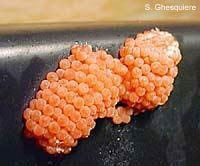 Bright yellow eggs of Pomacea canaliculata. The eggs of Pomacea diffusa are more pinkish in colour. |
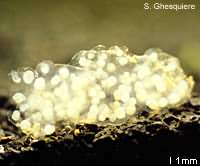 Aquatic egg clutch of Marisa cornuarietis or Giant Ramshorn snail. |
|
|
Baby snails
After 2 to 4 weeks (depending of the temperature) the little snails are
about to hatch. The egg clutch becomes darker and finally the little snails
eat their way out and let they drop in the water.
As many fish eat those little snails, it's a good idea to transfer the little
snails to a separate tank. While it's quite difficult to catch the little snails
without causing damage, it fairly easy to transfer the egg clutch before they
hatch: wet the eggs and the surface it's attached to and wait a little time.
Then try to move the clutch over the surface until it looses and put it somewhere
on a floating object in the new tank. Another way is to wait until the snails
are about to hatch and then remove the clutch without bothering about breaking
it and put it on a floating object or even wash the little snails out of the
clutch by keeping it in the water and rolling it between your fingers. This
method delivers high numbers of healthy little snails if done carefully.
During the first days after hatching the little snails feed on soft algae, waste
and food leftovers. This is always available in a stable tank, but can be absent
in a new tank, so prepare the snail tank at least 2 weeks before the snails
hatch or feed them with fine fish food. After one to two weeks, the little snails
are able to eat the same as their parents.
Common questions
Can apple snails become a pest in my tank?
No, an apple snail population in a tank or pond is fairly easy to control. The
adult snails are easy to spot and the eggs are difficult to overlook. Just take
them away to prevent overpopulation.
How old will they get?
Depending on the species, the temperature and other factors, the expected lifetime
of an apple snail ranges from 1 year to more than 4 years.
My snail is floating around for a day now. Is he/she dead or what? What
should/can I do?
It's not uncommon for an apple snail to float when they have much air in their
lung. It's also not uncommon for an apple snail to be inactive for days or even
weeks, especially older snail can be very inactive. So floating around for days
does not necessary mean that the snail is sick or dead.
If the snail however starts to smell bad or when the body becomes very weak,
the snail could be indeed dead and should be removed immediately.
My fish have a disease and I want to treat them. Can those chemicals harm
my snails?
The basic principle in combating a fish disease is to use chemical compounds
that kill the disease, while having no adverse effects on the fish, due to neurological/metabolistic
differences between the organisms.
However, snails have more in common with many parasites than with fish in the
way they react to chemical substances. It's thus advised to isolate the snails
in a separate tank during treatment of the fish unless you are absolutely sure
that the product you use doesn't contain snail-toxic chemicals. And as many
disease causing organisms do not survive outside the fish during a few days,
together with repeated water changes in the isolation tank, the risk of reinfection
through the snail reintroduction can be minimised. Exceptions to this rule are
parasites that have a life cycle with snails and fish as intermediate hosts
(mainly the case with wild-caught fish/snails).
A short list with chemicals that are/could be toxic to snails in therapeutic
doses:
-Malachite Green (used to treat Ich or white spot, fungi and Velvet or Oodinium).
-Various organophosphorous pesticides like formaldehyde, metriphonate, trichlorphon
(= dylox, masoten, metriphonate, neguvon, trichlorophon), dichlorvos and others
used to treat infections with flukes, worms, crustaceans and lice.
-metaldehyde used as molluscicide. -Various copper containing drugs to treat
protozoa and fungus infections.
-Parricide D (Di-N-Butyl Tin Oxide) used to eliminate helminthes, acanthocephala,
trematodes, cestoda and worms.
Are snails able the hear anything?
No, apple snails have no ears and are completely deaf.
How well do they see?
They have eyes that should enable them to 'see' their environment, but do not
expect much from their vision. It's a rather poor vision that merely serves
to find the light and dark places.
![]()
| Text and illustrations: Stijn Ghesquiere Translation: (your name) |